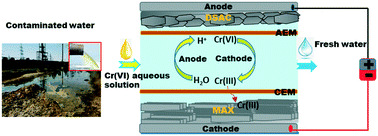The fabrication of activated carbon and metal-carbide 2D framework-based asymmetric electrodes for the capacitive deionization of Cr(vi) ions toward industrial wastewater remediation
Abstract
A new asymmetric pseudocapacitive deionization (CDI) cell was assembled with date seed-derived activated carbon (DSAC) as an anode and MAX (Ti3AlC2) as a cathode for the deionization of the Cr(VI) ions from industrial effluents. A simple pyrolysis method was used for the synthesis of mesoporous DSAC from the date-seed feedstock. The commercially available Ti3AlC2 possessed stacked multilayered arrangements of metal-carbide 2D frameworks with a specific capacitance of 347 F g−1 in a 1 M Na2SO4 solution at a scan rate of 10 mV s−1 with excellent stability and low internal resistance. The designed asymmetric DSAC//MAX-based CDI system exhibited high Cr(VI) adsorption capacity of 38.6 mg g−1 with high removal efficiency and significant regeneration behavior at 1.2 V in a 120 mg L−1 Cr(VI) solution at neutral pH. In this asymmetric CDI system, DSAC generated hydrogen ions via electrolysis of water, which contributed to the reduction of the Cr(VI) ions. Furthermore, the toxic Cr(VI) ions were electrochemically converted into Cr(III) on the surface of the stacked layers of Ti3AlC2. The present work shows the potential of using an asymmetric DSAC//MAX-based CDI system for the abstraction of hazardous pollutants from industrial effluents.

- This article is part of the themed collection: Capacitive deionisation and electrosorption 2020


 Please wait while we load your content...
Please wait while we load your content...